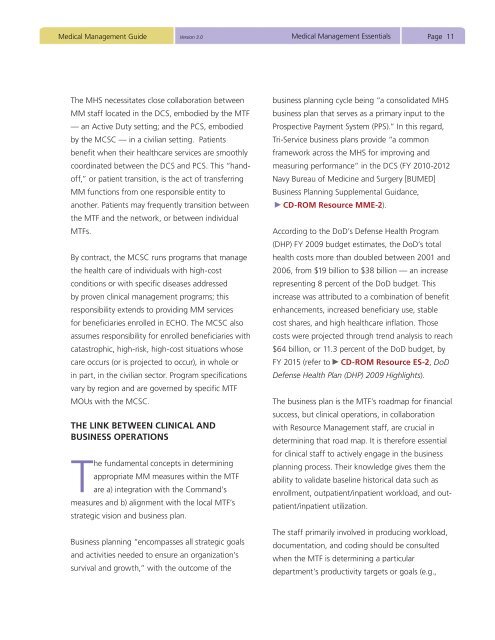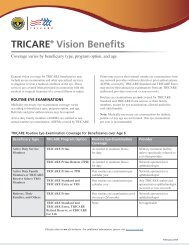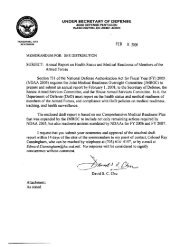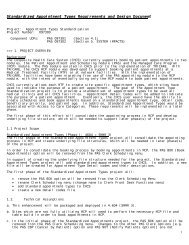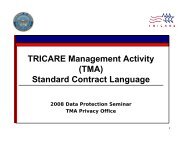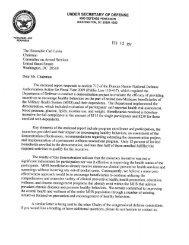Medical Management Guide, 2009, Version 3.0 - Tricare
Medical Management Guide, 2009, Version 3.0 - Tricare
Medical Management Guide, 2009, Version 3.0 - Tricare
- No tags were found...
Create successful ePaper yourself
Turn your PDF publications into a flip-book with our unique Google optimized e-Paper software.
<strong>Medical</strong> <strong>Management</strong> <strong>Guide</strong> <strong>Version</strong> <strong>3.0</strong><strong>Medical</strong> <strong>Management</strong> EssentialsPage 11The MHS necessitates close collaboration betweenMM staff located in the DCS, embodied by the MTF— an Active Duty setting; and the PCS, embodiedby the MCSC — in a civilian setting. Patientsbenefit when their healthcare services are smoothlycoordinated between the DCS and PCS. This “handoff,”or patient transition, is the act of transferringMM functions from one responsible entity toanother. Patients may frequently transition betweenthe MTF and the network, or between individualMTFs.By contract, the MCSC runs programs that managethe health care of individuals with high-costconditions or with specific diseases addressedby proven clinical management programs; thisresponsibility extends to providing MM servicesfor beneficiaries enrolled in ECHO. The MCSC alsoassumes responsibility for enrolled beneficiaries withcatastrophic, high-risk, high-cost situations whosecare occurs (or is projected to occur), in whole orin part, in the civilian sector. Program specificationsvary by region and are governed by specific MTFMOUs with the MCSC.THE LINK BETWEEN CLINICAL ANDBUSINESS OPERATIONSThe fundamental concepts in determiningappropriate MM measures within the MTFare a) integration with the Command’smeasures and b) alignment with the local MTF’sstrategic vision and business plan.Business planning “encompasses all strategic goalsand activities needed to ensure an organization’ssurvival and growth,” with the outcome of thebusiness planning cycle being “a consolidated MHSbusiness plan that serves as a primary input to theProspective Payment System (PPS).” In this regard,Tri-Service business plans provide “a commonframework across the MHS for improving andmeasuring performance” in the DCS (FY 2010-2012Navy Bureau of Medicine and Surgery [BUMED]Business Planning Supplemental Guidance,CD-ROM Resource MME-2).According to the DoD’s Defense Health Program(DHP) FY <strong>2009</strong> budget estimates, the DoD’s totalhealth costs more than doubled between 2001 and2006, from $19 billion to $38 billion — an increaserepresenting 8 percent of the DoD budget. Thisincrease was attributed to a combination of benefitenhancements, increased beneficiary use, stablecost shares, and high healthcare inflation. Thosecosts were projected through trend analysis to reach$64 billion, or 11.3 percent of the DoD budget, byFY 2015 (refer to CD-ROM Resource ES-2, DoDDefense Health Plan (DHP) <strong>2009</strong> Highlights).The business plan is the MTF’s roadmap for financialsuccess, but clinical operations, in collaborationwith Resource <strong>Management</strong> staff, are crucial indetermining that road map. It is therefore essentialfor clinical staff to actively engage in the businessplanning process. Their knowledge gives them theability to validate baseline historical data such asenrollment, outpatient/inpatient workload, and outpatient/inpatientutilization.The staff primarily involved in producing workload,documentation, and coding should be consultedwhen the MTF is determining a particulardepartment’s productivity targets or goals (e.g.,


